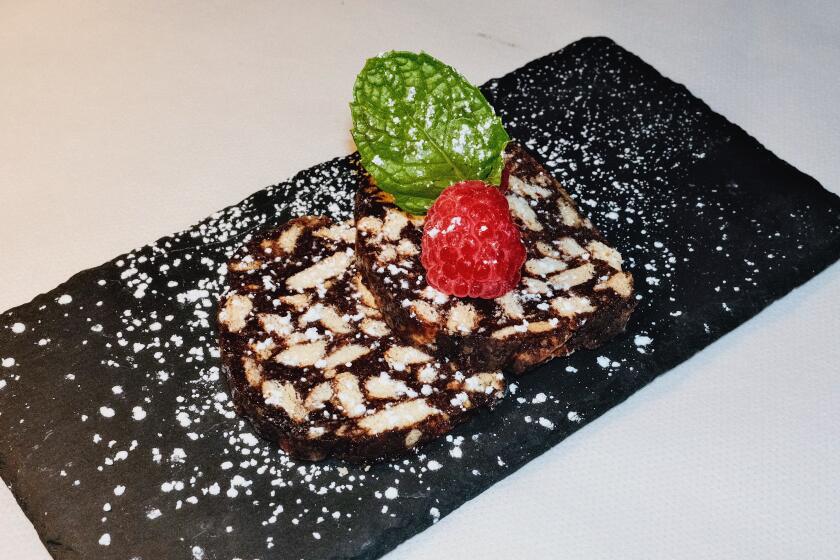Red currant and raspberry granita

- Share via
You see them for a few summer weeks in farmers market stands, baskets of fresh currants in gorgeous garnet clusters. Then they’re gone, before most of us figure out what to do with them. Luckily, some produce importers -- impressed by their festive beauty -- bring red currants back for the holidays.
For the weeks around Christmas, you can find the berries, from Chile or New Zealand, in produce aisles instead of market stands. (Whole Foods and Gelson’s have them now.) They’re like crimson holiday lights, bright and lustrous as glass, briefly captured in a convenient clamshell.
Although you could string them on your tree -- a more delicate version of the cranberries that kids like to intersperse with popcorn -- or display them on your countertop, take a tip from Elizabeth David, the late, celebrated English food writer, and cook with them instead.
David didn’t just treat the gorgeous fruit like misplaced jewelry; she used them to make jams, granitas and ice creams and summer bread pudding. She also loved them in Cumberland sauce, a vibrant crimson sauce made with blanched citrus and shallots, then spiked with port, vinegar, mustard and ginger -- and a generous dose of red currant jelly, traditionally served with cold venison.
Fresh currants, which can be red, black or even white, are different than dried currants; they come from an entirely separate family of plants, and are related to gooseberries. Black currants, too tart to eat fresh, are used in syrups and jams and creme de cassis. White currants, which farmer Randy Pudwill grows near Pismo Beach and sells at farmers markets in the summer, are sweet enough to eat off the vine.
Red currants are quite tart, but you can eat them right off the stems, little pips and all.
Whether kept intact on the vine for desserts, picked and tucked inside berry pies, cooked into sauces or matched with roasts, currants have a bright astringency that works equally well with sweet or savory fare.
The tartness of the berries is a great foil for rich dishes such as duck, game and even foie gras -- and the gorgeous color provides lovely juxtaposition with the dark meats, especially when taken down into preserves or jellies.
Their dense flavor is perfectly suited to jams and coulis, which also allow you to easily strain out the seeds. A bit of fine mesh is all it takes, unless you want to duplicate the technique used in Bar-le-Duc, a town in northeastern France famous for its red currant preserves. There, since the 14th century, the seeds have been removed from the fruit by hand. With a quill.
Though the strainer has since been invented, many chefs can’t resist leaving red currants intact.
Campanile chef Mark Peel loves to coat the berries, still on the vine, with egg white and sugar, allowing the coating to dry and encrust the berries like frost. Atop a slice of lemon tart, they look like something brought out from a museum vault instead of a walk-in refrigerator.
Judy Rogers, chef at San Francisco’s Zuni Cafe, likes to brandy the raw fruit still on the vine, then serve the bejeweled sprigs with pate, rabbit rillettes or almond panna cotta.
In desserts, the rather aggressive tartness of the berries needs a counterpoint, a cool touch or a sweeter note to underwrite their flavor. Pack currants into sponge cake for a traditional English summer pudding, the bland sweetness of the cake operating as the perfect foil for the berries. Or juice them into a vibrant syrup for a bowl of vanilla-bean ice cream; the soft flavors and pale color of the ice cream provide a lovely backdrop for the currants’ brightness.
David liked to match the currants’ acidic punch with the long, sweet notes of raspberries, straining the scarlet juices of both fruit into a dense, luscious granita. Simple and quick to make, it’s a perfect holiday dessert -- stunning in color and flavor. The icy scoops are reminiscent of the snow we don’t get, but in a dazzling vermilion.
In a blender, puree the currants with the raspberries. Press them through a stainless steel or nylon sieve (wire discolors the fruit) into a medium bowl, and add the lemon juice.
In a medium saucepan, bring one-half cup of water and the sugar to a boil. Boil until the mixture is a light syrup consistency, 4 minutes (for a more dense sorbet, boil until the syrup is thick, 7 minutes). Cool for a few minutes.
Stir the currant and raspberry mixture into the sugar syrup. Place the granita in a large glass baking dish, cover loosely with foil and allow to freeze, 2 to 2 1/2 hours.
Ten minutes before serving, transfer the granita to the refrigerator to soften. Serve.
Get our Cooking newsletter
Get a taste of Los Angeles — and the world — with recipes and kitchen tricks from the L.A. Times’ Cooking newsletter.
You may occasionally receive promotional content from the Los Angeles Times.
















